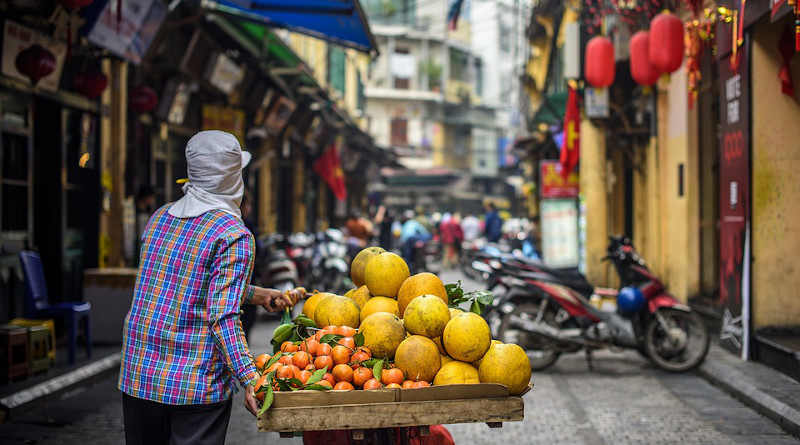Debunking Vietnam’s Currency Manipulation – Analysis
By David Dapice*
The US Treasury is investigating whether Vietnam is manipulating (over-devaluing) its currency. This is driven by a growing bilateral trade surplus with the United States — a variable of special concern to the current White House but to very few economists.
It is the overall trade balance which would be relevant. That is close to balance — the (relatively) large 2019 trade surplus was only 4 per cent of imports. Most other years this decade the trade balances have been smaller or even negative. Another test would be if foreign exchange reserves were ‘excessive’ and at 3–4 months of imports, they are well within the range of normal holdings.
One can also look at the evolution of the exchange rate. In 2010, there was a trade deficit and the exchange rate averaged 18,613 dong to the dollar. In 2019, with the overall modest trade surplus, it was 23,050 and is little changed for most of 2020.
But the inflation differential more than explained the dong’s movement. Vietnam’s GDP deflator grew 62 per cent from 2010 to 2019 while the US deflator was up 17 per cent. If Vietnam’s currency had depreciated by the amount of Vietnam’s ‘extra’ inflation, it would have depreciated by 38 per cent and the dong should have depreciated to more than 25,000. Under purchasing power economic theory, exchange rates reflect inflation differentials.
If Vietnam is manipulating its currency, it is keeping it overvalued and making it harder to export, not easier. So, what is going on?
In response to rising tensions with China and its rising labour costs, many companies adopted a ‘China+1’ strategy earlier in the last decade — often locating assembly factories for garments, shoes and electronics in Vietnam. With the more recent trade war sparked by US President Donald Trump, the policy changed to an ‘ABC’ (anywhere but China) strategy, and very quickly.
This has led to the migration of export production to Vietnam. Exports of goods rose from US$150 billion in 2014 to US$264 billion in 2019. They even grew in 2020, by 2 per cent through September. But imports of goods also grew quickly, from US$148 billion in 2014 to US$253 billion in 2019 — falling slightly (0.8 per cent) in 2020. The value added of the FDI exports is typically very low and a lot of the ‘Vietnamese’ surplus with the United States reflects imported inputs from the rest of Asia.
The IMF shows a current account surplus of 4.9 per cent of GDP in 2014 falling to 2.2 per cent of GDP in 2019. The balance on goods and services in 2020 through September was US$8 billion. Neither the trade surplus, current account balance or foreign exchange reserves show any sign of significant or increasing currency manipulation.
The values of other currencies — such as the euro and renminbi — are also important for Vietnam. The dollar was strong into 2019 due to Federal Reserve interest rate increases from near zero before 2016 to more than 2 per cent in late 2019 — at a time when EU and Japanese interest rates were much lower. The US trade deficit with all countries grew from US$490 billion in 2014 to US$617 billion in 2019. A large tax cut and full employment in the United States in 2017 increased demand and contributed to the growing trade deficit. The overall US trade deficit is largely caused by excess demand and a strong dollar.
The focus should be on the deluge of FDI — the World Bank data say there was a net inflow of US$9.2 billion in 2014 rising to US$16.1 billion in 2019. Much of this investment is aimed for export, but its production has low value added. An estimate for smart phone exports puts labour value added at 2 per cent of sales value and there are single digit estimates of total value added for chip assembly.
This is why the current account is nearly balanced — imports are coming in, little value added occurs and exports look big but mostly reflect production in other places. There is a remote possibility that Vietnam might seriously manipulate its currency in the future, but unlike China, it wants good relations with the OECD and the United States. It is much more willing to negotiate surveillance and management practices.
Some of the runup in exports is already hitting limits — the labour force wanting to work in factories is largely used up and there is a limited amount of agricultural labour willing and able to transfer to factories. Much of the declining agricultural labour force is aging. Young educated workers — increasing in number — do not aim for factory jobs.
This means the total factory labour supply may stagnate or even fall in the current decade. The main ‘crime’ of Vietnam is to be in the right place at the right time and to take advantage of global developments in which they have little influence.
It is likely that if Vietnam can spend more on infrastructure, it will. Its cities and rural areas need more transportation investments. Its electrical grid needs billions of dollars of upgrading. Water and sewerage systems need improvements. Such spending does not happen immediately, but it will follow. When it happens, imports will grow more than exports. Tariffs are low and falling.
The growth of smarter and cheaper robots and 3D printing is also likely to decrease demand for overseas labour. The United Nations estimates that robots could displace 75–85 per cent of labour in electronics assembly, garments and shoes — all major exports of Vietnam. If export production migrates to where it is consumed, Vietnam’s real economy and currency would both be in trouble.
*About the author: David Dapice is a senior economist in the Ash Center for Democratic Governance and Innovation at the John F Kennedy School of Government, Harvard University.
Source: This article was published by the East Asia Forum

